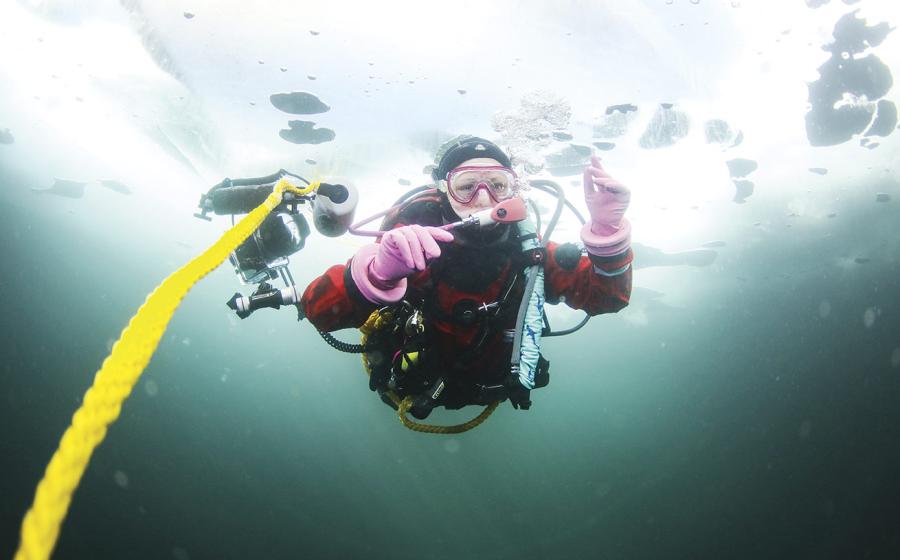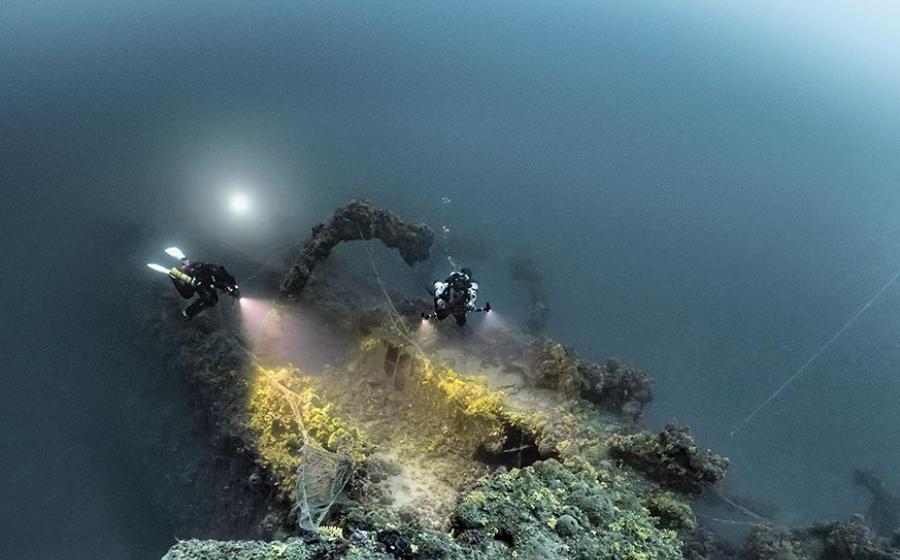Action Islands
The animal action is the hallmark of the remote Pacific islands of Cocos and Malpelo Hanging in mid-water schooling jacks completely enveloped me, darkening the sky and obliterating all else from view. They kept coming, an endless procession of silver elliptical bodies moving in every direction at once. This sort of energy and action in the water column defines and delineates diving at Cocos and Malpelo Islands.My 15-day itinerary aboard the Sea Hunter live-aboard combined these two remote but legendary islands of the eastern tropical Pacific. Costa Rica's Cocos, Colombia's Malpelo, and Mexico's Soccoro Islands are the corners of the Panamic Triangle, noted throughout the diving world for their wild, pristine marine life. There's little coral; the background is mostly bare rock. Visibility can be soupy at times, but the plankton is the base of a food chain that supports everything from whale sharks to marlin to hammerheads. Malpelo IslandOccasionally a dive turns into total chaos. I was being tossed about like dirty laundry in a washing machine as the tightly bunched schools of creole fish and jacks, riding that same surge, were flickering in and out of focus across the diagonal thermocline. Thermoclines, the meeting line between colder and warmer waters, are usually horizontal, but the violent water movement spilled the blurry layer across my field of vision, making any attempt at photography futile. To tell the truth, I was concentrating primarily on self-preservation, grabbing barnacle-encrusted rocks with my Kevlar-encrusted gloves. As the current blew me off the reef, the concept finally dawned on me: these conditions wouldn't allow any serious diving today. This was my rude introduction to Malpelo Island.Two miles long and a half-mile wide, the stark rock of Malpelo arises out of mid-ocean with nothing on it but some scrub grasses, hordes of seabirds, and one tiny shack that's home to a half dozen Colombian army troops. Coming aboard to check our documents, they looked like teenagers playing soldier in ragtag uniforms. I wondered what these kids had done wrong to get assigned to such a godforsaken post. On the following day Mother Ocean showed a friendlier face. She had calmed but the spring bloom had reduced visibility to 35 feet. Through the haze I spotted three dozen hammerhead sharks parading to their cleaning stations, where palm-sized barberfishes were waiting to service them. Despite their bizarre appearance, hammerheads are shy and skittish in the presence of divers' bubbles, so the strategy is to hunker down where the cleaners are and wait for a shark to move in I was enraptured by the hammerheads. No matter how often I've seen them, hammerheads are always special. Their size and bulk, their sinuous grace, and above all their outlandish eye stalks lend a primeval appearance, although compared to other sharks, they are a relatively young species. Most of these were females, their skin marked with jagged scars from love-bites of their mates.It's hard not to become obsessed with hammerheads at the expense of ignoring all the other critters at Malpelo. Moray eels 5 to 6 feet long slithered along the rocks, swimming freely out of their holes. Leather bass were attacking sea urchins for the cardinalfish hiding among their spines; trumpetfish were swimming alongside groupers for cover. But like watching a three-ring circus, my attention was split between the reef and the water column, because so much was going on overhead.Silvery bigeye jacks were swarming in a huge school, many of the males decked out in their black mating outfits, swimming in synchronicity with their chosen partner. A vast school of creolefish almost blotted out the sun. And Almaco jacks, at nearly 5 feet long, were easily the largest I'd ever seen. Cocos IslandThe boat trip from Melpelo to Cocos takes 30 hours, which was more than enough time for six of us to learn to dive with rebreathers. They would come in handy for photographing the sharks that school here at sites such as Dirty Rock, Manuelita, and Alcyone.Although hammerheads are the major attraction, whitetip reef sharks are far more common, so much so that after a while you tend to ignore them. This is especially true since, unlike most sharks, whitetips often rest on the bottom. Up to a half-dozen may be jammed unmoving into a single narrow crevice.Another impressive critter found in abundance at Cocos is the marble ray. These disk-shaped stingrays are 4 to 5 feet across, decorated with a mottled black-and-white pattern. Swimming toward you, they look like the Starship Enterprise.The crew was constantly on the lookout for swarms of diving birds, the indication of a baitball below the surface. Ever since Sea Hunter's co-owner Avi Klapfer shot incredible video footage of a baitball, they have become a major attraction of Cocos and Malpelo diving.It all begins when dolphins herd small baitfish into a compact, whirling mass, then feed on the trapped, panicked prey. Other predators, from oceanic blacktips to marlins to giant tuna, join in the feeding orgy. As these fish charge the baitball, divers can actually hear the crunch of the prey being eaten.Even if you take away the sharks and the baitballs, the islands of Cocos and Malpelo are still spectacular. They are among the few places in the world where the marine environment hasn't been altered by fishing, fish feeding or too many people, and they are likely to stay that way. Both are national parks, where no-fishing policies are enforced by on-site government personnel. Their remote location keeps pressure off, restricted to a few vessels that practice low-impact, no-interference diving. It's a rare opportunity for us to see a virtually pristine ecosystem, where humans are not ecologically dominant, but just another species in the water column. For reservations and more information about diving Cocos and Malpelo islands, click on the home page below. For general information about visiting Costa Rica, click on the home page below.






